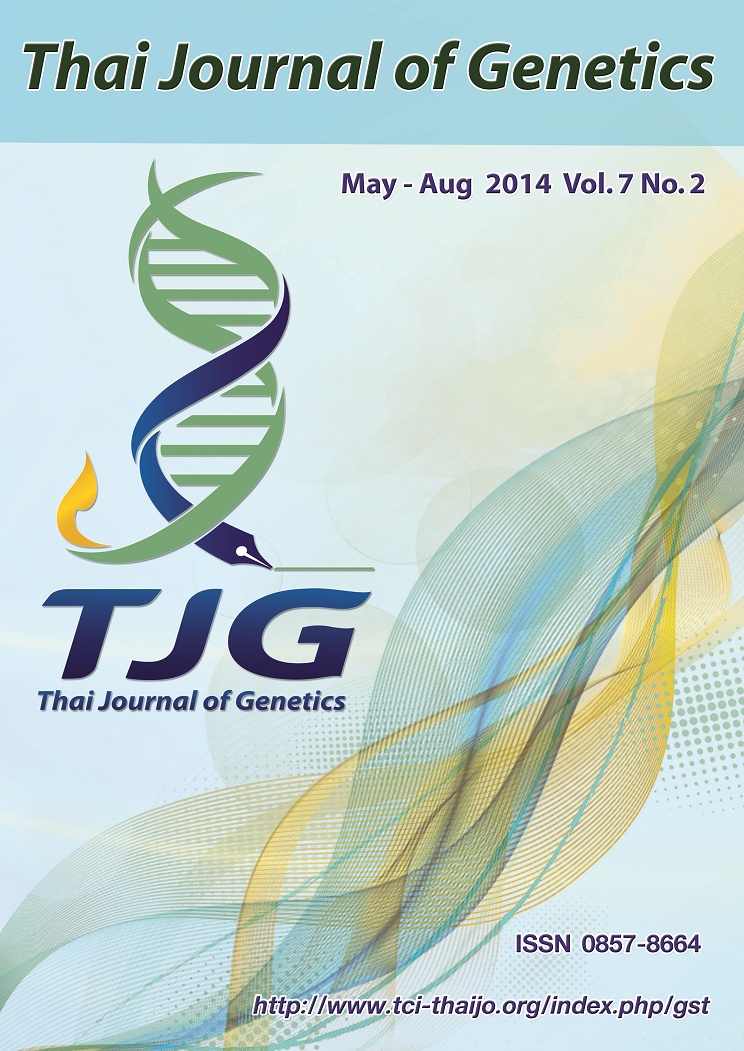Analysis of paternity testing results by Identifiler system in Thailand
DOI:
https://doi.org/10.14456/tjg.2014.14Keywords:
paternity testing, autosomal STR markers, combined paternity index, power of exclusion, ThailandAbstract
One of the applications of Identifiler™system is to use for paternity testing. This study aims to analyze the paternity testing results of trio and duo cases. A total of 500 paternity cases were divided into 120 trio and 380 duo cases. Combined paternity index (CPI) and power of exclusion (PE) were calculated for inclusion and exclusion results. Based on statistical analysis, the lowest CPI value obtained from trio cases was 1,340.89 with a probability of paternity more than 99.92%. In duo cases, the lowest value of CPI was 32.18 with a probability of paternity higher than 96.98%. Moreover, we noticed that approximately 50% of the CPI values in trio and duo cases were in a range of 106–108 and 104–106, respectively. For exclusion results, D2S1338 had the highest PE value in trio cases (81.20%). In duo cases, D8S1179 showed the highest PE value (75.80%). TPOX had the lowest PE value in both trio and duo cases (29.10% and 24.60%). The minimal numbers of excluding loci were 7 and 3 in trio and duo cases, respectively. In addition, this study showed that a threshold value for CPI should be greater than or equal to 1,000.
References
Ayadi I, Mahfoudh-Lahiani N, Makni H, Ammar-Keskes L, Reba A (2007) Combining autosomal and Y-chromosomal short tandem repeat data in paternity testing with male child: methods and application. J Forensic Sci 52: 1068–1072.
Babol-Pokora K, Jacewicz R, Pepinski, Szram S (2006) Identifiler™system as an inadequate tool for judging motherless paternity cases. IntCongrSer 1288: 462–464.
Barbaro A (2012) Progress in Forensic Genetics: New Markers Validation Studies and Population Data. PhD Academic Thesis. The University of Santiago de Compostela.
Brenner CH MJ (1990) Paternity Index Calculations in Single Locus Hypervariable DNA Probes. Validation and Other Studies Proceedings for The International Symposium on Human Identification 1989. Promega Corporation: 21–53.
Butler JM (2005) Forensic DNA Typing Biology: Technology and Genetics of STR markers. 2nd ed. Elsevier Academic Press.
Butler JM (2006) Genetics and genomics of core STR loci used in human identity testing. J Forensic Sci51: 253–265.
Butler JM (2012) Chapter 5 Short Tandem Repeat (STR) Loci and Kits. In: J. M. Butler (Eds) Advanced Topics in Forensic DNA Typing. San Diego Academic Press, pp 99–139.
Chanpreechaya P, Taechowisan T (2009) Allele frequencies and statistic analysis of 15 STR loci in thai population. The science journal of PhetchaburiRajabhat University 1: 46–54.
El-Alfy SH, Abd El-Hafez AF (2012) Paternity testing and forensic DNA typing by multiplex STR analysis using ABI PRISM 310 Genetic Analyzer. Genet EngBiotechnol J 10: 101–112.
Gjertson DW, Brenner CH, Baur MP, Carracedo A, Guidet F, Luque JA, Morling N (2007) ISFG: recommendations on biostatistics in paternity testing. Forensic Sci Int Genet 1: 223-231.
Jacewicz R, Berent J, Prosniak A, Kadlubek M, Szram S (2004) The evaluation of the IDENTIFILER system in paternity testing in Poland. IntCongrSer 1261: 538–540.
Miller KWP, Brown BL, Budowle B (2003) The combined DNA index system. IntCongrSer 1239: 617–620.
Oliveira S, Trindade-Filho A, Mendes C, Paula K, Maia F, Pak H, Dalton G (2006) Power of
exclusion of 18 autossomic STR loci in a Brazilian Middle–West region population sample. Int CongrSer 1288: 433–435.
Panke S E, Schurdak E, Boyer T, King N (2001) DNA Paternity Tests Show Probability of Paternity of 99% in Non-fathers.Genetica DNA Laboratories, Inc., Cincinnati, Ohio.
http://www.dennisfuller.com/ (May 2014).
Rerkamnuaychoke B, Rinthachai T, Shotivaranon J, Jomsawat U, Siriboonpiputtana T, Chaiatchanarat K, Chantratita W (2006) Thai population data on 15 tetrameric STR loci—D8S1179, D21S11, D7S820, CSF1PO, D3S1358, TH01, D13S317, D16S539, D2S1338, D19S433, vWA, TPOX, D18S51, D5S818 and FGA. Forensic SciInt 158: 234-237.
Scientific Working Group on DNA Analysis Methods (SWGDAM) (2010) SWAGDAM Interpretation Guidelines for Autosomal STR Typing by Forensic DNA Testing Laboratories, http://swgdam.org/ (May 2014).
Shotivaranon J, Chirachariyavej T, Leetrakool N, Rerkamnuaychoke B (2009) DNA database of populations from different parts in the Kingdom of Thailand. Forensic Sci Int Genet 4: e37–e38.
Stephenson FH (2010) Chapter 13 Forensics and paternity. In: FH Stephenson (Ed) Calculations for Molecular Biology and Biotechnology. 2nd ed. Boston Academic Press, pp 423–446.
Tug A, Akduman G G (2009) General characteristics of paternity test applicants. Turk J Med Sci 39: 923–931.



